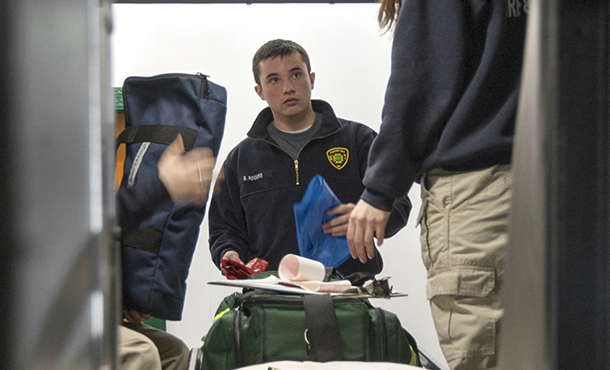Clover Hill Volunteer Fire Company rescue captain Blake Rogers [a senior who is double majoring in biology and environmental science at Eastern Mennonite University] reflects on what he considers the most memorable moment of his time with the agency.
“It happened after I received my ‘Enhanced,'” explained Rogers, in reference to an EMT-level he earned in January 2012. “Then, one day, we got a call about a diabetic emergency.”
On arriving to the scene in Clover Hill, Rogers encountered an unresponsive woman who had gone into diabetic shock, meaning her blood-sugar level dipped into the 20s – a normal blood-sugar level runs from 80-120.
Remembering what he had learned during his basic EMT training months prior, Rogers immediately set up an intravenous therapy and injected the woman with medication to raise her blood-sugar level. Minutes later, her blood-sugar level reversed, and the woman became alert and responsive.
“It was definitely a nerve-racking moment,” recalled Rogers, who was just two years removed from high school at the time. “But it was reassuring to see our training go into effect, which was a testimony to how hard we have worked.
“It’s always great to see that hard work pay off in the form of achieving an advanced level of care.”
Dedication and commitment
The Clover Hill Volunteer Fire Company – located on Clover Hill Road in Dayton – serves as a dual-purpose agency housing both volunteer paramedics and firefighters, a practice that is somewhat uncommon in the Valley.
“All of our members can function dual purpose, whereas Harrisonburg has their own rescue squad and their own fire department functioning as separate entities,” explained Rogers.
Rogers has been with the company for the last four years, serving as rescue captain for two. His demeanor is far more savvy than his 21 years would suggest.
As he toured the station – passing large, red engines and a tanker along the way – he was joined by 21-year-old Wanita King and 19-year-old Katie Lee, both of whom are EMTs with the agency.
“There’s a dedication and commitment by the people in their 20s,” said Rogers, when speaking about the company’s younger volunteers. “There’s about 10 to 15 individuals in their 20s that actively commit to running calls, so it’s a bit of a different atmosphere from most other squads or fire agencies.”
King noted that the number of young volunteers when she joined the agency at age 18 was lower, but over the years, more have joined, which somewhat eases the workload for everybody else.
“I’ve got to say, it’s been nice having more people taking calls,” she laughed.
Each individual volunteers 10 to 20 hours per week with the station, averaging one to two emergency calls each day – running the gamut from structure fires to medical emergencies – totaling about 60-70 calls as a whole, per month, stretching the Fulks Run-area to Augusta County.
The volunteers are dispatched through the station’s emergency communication system, which also sends out an alert to each person’s pager and cell phone, via email and text message.
“Sometimes, I’m sitting at work, we get an alert, and I start to worry about who is running the call,” said Lee, who works part-time as a receptionist at Virginia Mennonite Retirement Community.
“But I really don’t have to worry, because our volunteer system is awesome.”
Paramedic training
It’s worth noting that six squad members- including Rogers, King and Lee – are in the process of completing 600 classroom hours of paramedic training, along with 500 clinical hours, at Sugar Grove Navy Base in West Virginia. At the course’s completion, each squad member will be qualified to execute surgical and advanced airway procedures at emergency scene.
“We will all earn an associates degree in Emergency Medical Services from Blue Ridge Community and Technical College, in Martinsburg, W.Va.,” said Rogers, who added that all six members are on track to earn an associate’s degrees in emergency medicine.
“We all have taken basic prerequisites, like English, psychology and math, outside of the [paramedic] program in order to obtain the associates degree, as well.”
No higher reward
Though their dedication is evident by the time devoted, Rogers, King and Lee explained volunteer EMTs must have something more.
Rogers maintained that one must “be motivated and confident,” while Lee added that a person must be able to adapt to “unexpected” or “on the fly” situations that may occur on site.
King, who works full-time at Sentara RMH Medical Center as a patient care technician and part-time at G&W Ambulance, echoed Lee’s sentiments, adding that a person must be “fully committed” to the craft.
“You never know exactly what a call is going to end up being,” said King. “It could be a code that somebody isn’t breathing or it could be a code that somebody is dead. Either way, you have to be prepared to go under the job no matter what and be able to jump right in and just do it.”
While life as an EMT can be challenging and the situations can be tense, all three admit that, at the end of the day, there is “no higher reward” than saving someone’s life.
“After a while, you begin to sit back and think about the fact that `I actually helped save this woman’s life,’ or `I was involved in something that is bigger than myself,’ ” says Rogers, an aspiring physician’s assistant.
“I played a role as a team member in something that ultimately worked out for the community, and that is rewarding.”
– Courtesy of the Daily News Record, Mar. 4, 2014
